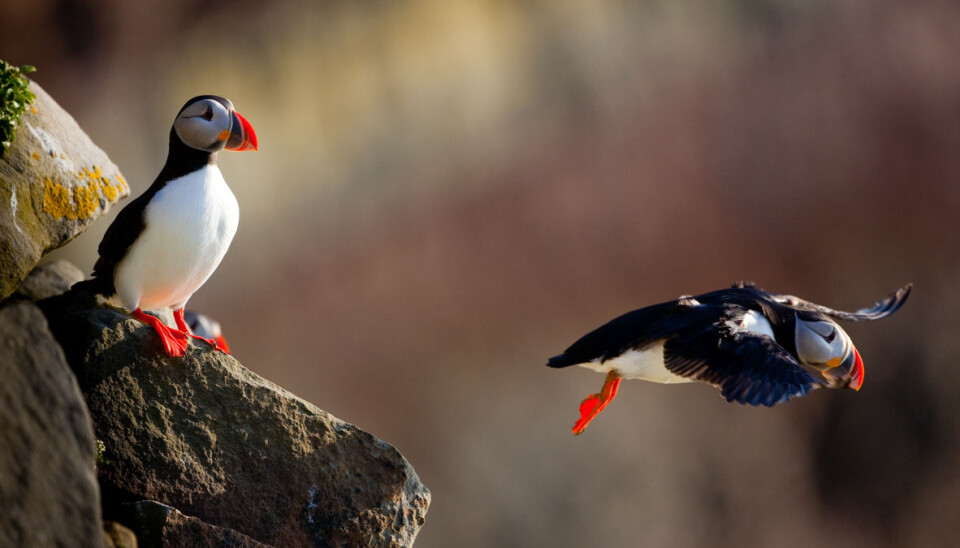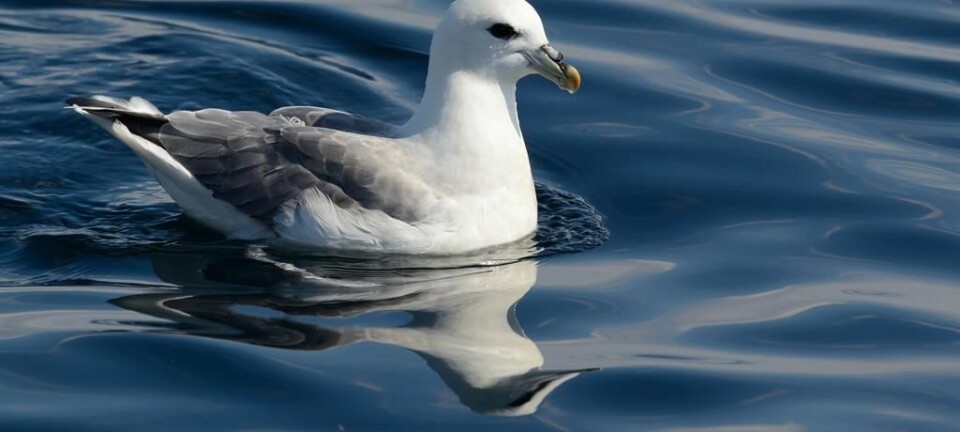An article from Norwegian SciTech News at NTNU

Uncovering the secrets of Arctic seabird colonies
Seabirds nest by the hundreds of thousands in colonies along the Norwegian coast. Now, scientists have uncovered the factors that help determine the location of seabird nesting colonies.
Ninety per cent of Norway’s two million pairs of cliff-nesting seabirds are located in nesting colonies above the Arctic Circle. But why are these colonies located exactly where they are?
Much of the 1200-km stretch of coastline from the Arctic Circle to Norway’s easternmost point, on the Russian border, has features that ought to be attractive to birds that nest in colonies, mainly steep, protected cliffs that are essentially inaccessible to terrestrial predators.
Using computer models to describe ocean currents and the transport of floating fish larvae, researchers were able to show that bird colonies are located in areas where currents and the shape of the coastline cause fish larvae to concentrate.
More simply stated, “the birds are where the food is,” said Hanno Sandvik, a biologist from the Centre for Biodiversity Dynamics at the Norwegian University of Science and Technology (NTNU) and first author of a paper published in Nature Communications on Friday.

This may seem like a self-evident fact, but the research team is the first ever to be able to essentially predict where seabird colonies should be, based on fish larvae “hot spots” that show up in computer models of how fish larvae are transported along the coast.
“We are starting from where the prey is,” Sandvik said. “We know where the prey is (because of the computer models). Then, based on what we know about where their prey is, where should the colonies be?”
Spotting a pattern in hot spots
The idea for the study came about several years ago, when researchers met to discuss a different project for which oceanographers from the Norwegian Institute of Marine Research (IMR) had created a coastal current and fish larvae transport model.
By using wind, water temperature and salinity information that has been collected by the Norwegian Meteorological Institute for decades, the oceanographers could calculate the strength and direction of currents along the Norwegian coast, and could simulate how fish larvae and plankton, which float with the current, would be transported.

The IMR researchers showed the assembled group of researchers a series of PowerPoint slides of the northern Norwegian coast with fish larvae concentrations mapped along the coastline over a number of years. They used red to show the densest concentrations, which meant that fish larvae “hot spots” were highlighted in red.
Although currents transport larvae and plankton along the entire coast, these floating organisms are not uniformly spread along the coastline. That’s because of the way the current interacts with different coastal features, which concentrate organisms in the eddies that form along banks, islets and promontories.
After Robert Barrett, a biologist from the Department of Natural Sciences at the Tromsø University Museum, saw several of the slides, he realized that the red “hot spots” were in exactly the same place every year, and their location neatly predicted seabird colony locations.
“I said, ‘Hang on! Let’s have a look at that,'” said Barrett, who is also the second author on the paper. “Those red concentration dots are distributed exactly where the seabird colonies are.”
It was then that the researchers decided to develop a statistical test to see if northern Norway seabird colonies are in fact closely associated with areas along the coast where currents concentrate food.
“We had been discussing for a long time why seabird colonies are where they are,” Barrett said. “Here the IMR researchers were showing us models of fish larval concentrations, and it fit. The food, of course, is totally dependent on ocean currents, climate and topography. It turns out that yes, there are hot spots along the coast where food is concentrated. And this is what the seabirds have tuned into long, long ago.”
Timing, stability important
For the research presented in the Nature Communications article, the IMR oceanographers simulated what the fish larvae and plankton concentrations would have looked like along the northern Norwegian coast each year from 1982 to 2011, or for 30 years. Sandvik and his other colleagues then combined this with seabird population numbers collected by the Norwegian Institute for Nature Research to see what kinds of patterns emerged.
So, for example, it is well known that July, which is relatively late in season for nesting seabirds, is a very important month when it comes to parents feeding their chicks. The chicks are nearly ready to leave the nest, so they are quite large and need a lot of food. That means the parents are working overtime to feed them.
Because of this demand, high fish larvae concentrations in July were among the most strongly associated factors with the presence of a nesting colony.
Sandvik also found that colony locations were strongly associated with locations where fish larvae concentrations had a high minimum level across many years. If an area along the coast had very high levels of fish larvae concentrations, but if those levels were not consistent over the years, then a colony was less likely to be associated with that spot.
“Birds prefer places where the (prey) numbers are as stable as possible,” Sandvik said. “The best places are where you have enough fish larvae every year.”
This makes sense from a biological standpoint because seabirds can’t suddenly change their reproductive abilities from year to year–they can’t lay 10 eggs in a good year and one egg in a bad year. So the birds simply can’t take advantage of years when there is a lot of prey in the ocean.
But if prey is available nearly every year at the minimum level needed for birds to reproduce successfully, that is much more attractive to seabirds — and the research backs this up.
Lofoten key, stable source of cod
One other surprising finding was the importance of cod larvae that originate from spawning grounds in the Lofoten Islands, Sandvik said.
The two currents that are responsible for moving water along the northern Norwegian coast move north and then east, wrapping around the top of Norway near Hammerfest and heading east towards Kirkenes. These currents thus bring cod larvae north from spawning grounds and then east along the coastline.
If Sandvik looked just at concentrations of herring larvae, there was no significant association between herring and colony location. But if he looked at cod larvae, the association between larvae concentrations and colony location was highly significant, he said.
The Lofoten area has continually exported dried cod since the Viking times, 900 years ago, which suggests that the cod spawning area there has been stable over long periods, Sandvik said. That means it’s possible that the location of the seabird colonies in northern Norway might have persisted for centuries, if not longer.
“It really seems to be the area that is driving this entire system,” he said.
In addition to IMR and the Tromsø University Museum, the scientists involved in the research came from the Norwegian Institute for Nature Research and the University of Tromsø -The Arctic University of Norway.

































